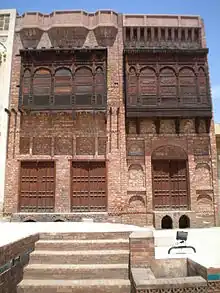خشت
Khalaj
Noun
خِشت (xişt) (definite accusative خِشتی, plural خِشتلَر)
Persian
Pronunciation
- (Classical Persian) IPA(key): [xiʃt]
- (Dari, formal) IPA(key): [xɪʃt̪]
- (Kabuli) IPA(key): [xɪʃt̪]
- (Hazaragi) IPA(key): [xiʃt̪]
- (Iran, formal) IPA(key): [xeʃt̪]
- (Tajik, formal) IPA(key): [χiʃt̪]
| Readings | |
|---|---|
| Classical reading? | xišt |
| Dari reading? | xišt |
| Iranian reading? | xešt |
| Tajik reading? | xišt |
Etymology 1
See Old Armenian աշտեայ (ašteay).
References
- Steingass, Francis Joseph (1892) “خشت”, in A Comprehensive Persian–English dictionary, London: Routledge & K. Paul
- Hübschmann, Heinrich (1897) Armenische Grammatik. 1. Theil: Armenische Etymologie (in German), Leipzig: Breitkopf & Härtel, page 510
Etymology 2
From Middle Persian [script needed] (hšt' /xišt/, “brick”), from Old Persian 𐎡𐏁𐎫𐎡 (i-š-t-i /išti-/, “sun-dried brick”), possibly borrowed from the BMAC substrate.[1][2] Cognate with Avestan 𐬌𐬱𐬙𐬌𐬌𐬀 (ištiia, “brick”), 𐬌𐬱𐬙𐬌 (išti), 𐬰𐬆𐬨𐬋𐬌𐬱𐬙𐬎𐬎𐬀 (zəmōištuua, “clay brick”), Sanskrit इष्टका (iṣṭakā, “brick”), Tocharian B iścem (“clay”), Pashto خښته (ḵẖaś̱ẖtaʿh), and possibly Parthian 𐫍𐫏𐫢𐫎𐫏𐫃 (hyšṯyg, “brick”).
Derived terms
- خشتی (xešti)
Descendants
References
- The template Template:R:iir:Lubotsky:1999 does not use the parameter(s):
2=*išt(i̯)a- `brick'
Please see Module:checkparams for help with this warning.Lubotsky, Alexander (1999) “The Indo-Iranian substratum”, in Early Contacts between Uralic and Indo-European: Linguistic and Archaeological Considerations, Helsinki, page 4 - Schmitt, Rüdiger (2017–2018) “Chapter XVII: Indo-Iranian”, in Klein, Jared S., Joseph, Brian D., Fritz, Matthias, editors, Handbook of Comparative and Historical Indo-European Linguistics: An International Handbook (Handbücher zur Sprach- und Kommunikationswissenschaft [Handbooks of Linguistics and Communication Science]; 41.2), Berlin, Boston: De Gruyter Mouton, →ISBN, § The lexicon of Indo-Iranian, page 1949: “*išta-, *išti- ‘brick’”
Urdu

خِشت کا گَھر
a brick house
a brick house
Etymology
Borrowed from Classical Persian خِشت (xišt, “brick”), doublet of اِیْنٹ (ī̃ṭ). Ultimately derived from the BMAC substrate.
Cognate with Punjabi اِٹّ (īṭṭ), Pashto خښته (ḵẖaś̱ẖtaʿh), Khowar اݰٹو (ušṭu), Phalura اݜٹو (iṣṭū́),
Pronunciation
- (Standard Urdu) IPA(key): /xɪʃt̪/
Derived terms
- خِشْتِی (xiśtī, “(made of) brick”)
- خِشْتَک (xiśtak, “small brick”)
- خِشْت ساز (xiśt sāz, “brick-maker”)
- خِشْت زَنِی (xiśt zanī, “brick-making”)
References
- “خشت”, in اُردُو لُغَت (urdū luġat) (in Urdu), Ministry of Education: Government of Pakistan, 2017.
- Qureshi, Bashir Ahmad (1971) “خشت”, in Kitabistan's 20th Century Standard Dictionary, Lahore: Kitabistan Pub. Co.
- Platts, John Thompson (1884) “خشت”, in A dictionary of Urdu, classical Hindi, and English, London: W. H. Allen & Co., →ISBN, →OCLC
- “خشت”, in ریخْتَہ لُغَت (rexta luġat) - Rekhta Dictionary [Urdu dictionary with meanings in Hindi & English], Noida, India: Rekhta Foundation, 2024.
This article is issued from Wiktionary. The text is licensed under Creative Commons - Attribution - Sharealike. Additional terms may apply for the media files.
.jpeg.webp)